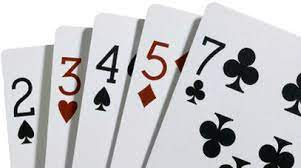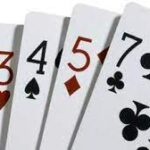One of the most basic things you need to know about no-limit 2-7 single draw is how the probabilities work for different types of starting hands. We’re going to start off with a look at pat hands in this game and how the range distributions work out. In hold’em, the distributions are fairly linear and straight-forward. However, in no-limit 2-7 single draw, the distributions are based on summations of the triangular numbers which is not something that most people have a basis for understanding on an intuitive level. We’re going to show you what the triangular numbers are, how they work to form hand combinations for this game, and how you can work on building a feel for these distributions.
The Triangular Numbers
Most people have stacked bottles or boxes up into pyramids before. This formation creates a triangle, and the sizes of the different available triangles make up what are known as the triangular numbers. Thanks to my excellent skills with MS Paint, here’s a quick set of examples of how the first five triangular numbers are formed:
 The first few triangular numbers are 1, 3, 6, 10, 15, 21, 28, 36, 45 and 55. Fun fact: If you’re familiar with hold’em hand combinations, you’ll notice that the first three triangular numbers list out the number of ways you can have pocket pairs with different blockers on the board.
The first few triangular numbers are 1, 3, 6, 10, 15, 21, 28, 36, 45 and 55. Fun fact: If you’re familiar with hold’em hand combinations, you’ll notice that the first three triangular numbers list out the number of ways you can have pocket pairs with different blockers on the board.
For 2-7 single draw, we can use sums of the triangular numbers to figure out how many different ways we can be dealt different hands. I’m not going to get into a whole bunch of super heavy-duty mathematical explanation about why this works, but I’ll give you enough to go on if you’re wanting to work things out on your own.
Starting Pat Hand Combinations in 2-7 Draw
If you have five cards that are X or under, then one of those sets of five cards will be a straight. For example, the ways to have five cards that are 7 or under are: 75432, 76432, 76532, 76542 and 76543. There are five ways to have them, but one of those is a straight. Four of each of the ways to have those different hands will also be flushes. Straights and flushes are mediocre drawing hands at the very best in no-limit 2-7 single draw, so we aren’t going to be counting those as pat hands.
However, this presents a bit of a problem. There are 1,024 ways to be dealt five cards of different ranks, so if you are looking specifically at the nuts 75432, there will be a total of 1,020 ways to be dealt that hand compared to 4 ways to be dealt those five cards in a flush. This is about 0.4 percent of the time, so for our purposes, we’re basically going to ignore the flushes. We’re not going to ignore the straights, though, but we’ll get around to how to handle those in a moment.
Adding Up the First X Triangular Numbers
If you look at just the first triangular number, you have 1. If you add up the first two triangular numbers, you get 4. Add up the first three triangular numbers to get 10. You’ll get 20 if you add up the first four triangular numbers, you’ll get 35 if you add up the first five, and 76 will be the result if you add up the first six of them. Why do these numbers (1-4-10-20-35-76) matter? Because they tell you the ways you can be dealt a hand in 2-7 single draw.
In this game, we typically describe hands by the highest two cards that they use. For example, we might say we had a 8-5 against a 9-7 as short for saying we had 85432 against something like 97642, or we might make fun of a fish for going all-in pre and standing pat with his awesome (note the sarcasm) Q-T.
The second card in this description is our kicker, and it’s also the key to knowing how many ways you can be dealt a hand. For example, there are the same number of ways to be dealt an 8-6 as a 9-6 or a T-6, and there are the same number of ways to be dealt an 8-7 as a 9-7, T-7 or J-7. The six lowest kickers you can have, and the only six kickers that really matter in this game are 5, 6, 7, 8, 9 and T. You can be dealt hands with these kickers 1, 4, 10, 20, 35 or 76 ways, respectively.
Practical Examples
So how many ways can you be dealt a pat 8? Well that would be the total of all of the ways of being dealt an 8-5, 8-6 and 8-7. You can be dealt an 8-5 just 1 way, and 8-6 can be dealt 4 ways, and an 8-7 can be dealt 10 ways. The total of this is 15 ways that you can be dealt a pat 8 without taking out the straights.
How many ways can you be dealt an 8-6 or better? To find this, you have to add up the ways to be dealt all of the hands that are an 8-6 or better. They are 7-5(1), 7-6(4), 8-5(1), and 8-6(4), for a total of 1+4+1+4 = 10 ways without accounting for straights.
Keep in mind that when we say 10 ways, that means there are 10 different hands that can be made with 1,024 combinations each, but four of those combinations will be flushes like we talked about above. That’s not really enough to worry about, but we will need to worry about the combinations of straights, so let’s look at that now.
Accounting for Straights
With this method, one thing you have to do is account for straights. There are four different ways to be dealt a 7-6, but one of those is going to be 76543, so you have to adjust your calculations to reflect that. Along similar lines, there are 10 ways to be dealt an 8-7, but one of those will be a straight, so you need to subtract it from the bunch.
Overall, accounting for straights is pretty easy, and you just have to pay attention to what you’re doing when you’re counting the ways to be dealt hands in a given scenario.
Learn More
No-Limit 2-7 Single Draw Strategy (Part 1): The Basics
No-Limit 2-7 Single Draw Strategy (Part 2): Pat Hand Combinations
No-Limit 2-7 Single Draw Strategy (Part 3): Draw Combos
No Limit 2-7 Single Draw Strategy (Part 4): Pre-Draw Overview
No-Limit 2-7 Single Draw Strategy (Part 5): Post-Draw With Draws
Submit your review | |






